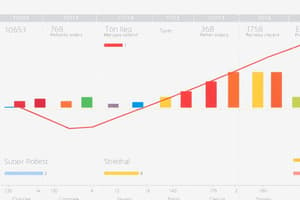Podcast
Questions and Answers
What is a key component of the control process in strategic management?
What is a key component of the control process in strategic management?
- Creating marketing strategies
- Conducting employee performance reviews
- Developing new strategic initiatives
- Collecting performance data and activity reports (correct)
Which of the following best describes output controls?
Which of the following best describes output controls?
- They set guidelines for employee conduct.
- They focus on the methods used to achieve results.
- They concentrate on the final results achieved through performance. (correct)
- They are designed to manage resource allocation.
How should performance be measured following the implementation of strategies?
How should performance be measured following the implementation of strategies?
- Using objectives established during the strategy formulation phase (correct)
- Based on the latest industry trends
- By comparing with competitors' performance
- Through employee satisfaction surveys
What initiates a strategy review in the control process?
What initiates a strategy review in the control process?
What type of control focuses on the resources utilized in performance?
What type of control focuses on the resources utilized in performance?
Which of the following is an obstacle to effective control?
Which of the following is an obstacle to effective control?
In strategic management, what is the purpose of evaluating implemented strategies?
In strategic management, what is the purpose of evaluating implemented strategies?
What factor should be considered when selecting measures for assessing performance?
What factor should be considered when selecting measures for assessing performance?
When should input controls be most appropriately applied?
When should input controls be most appropriately applied?
Which type of control is most suitable when specific output measures are agreed upon but the cause-effect connection is not clear?
Which type of control is most suitable when specific output measures are agreed upon but the cause-effect connection is not clear?
Why do corporations following the strategy of concentric diversification utilize all three types of controls?
Why do corporations following the strategy of concentric diversification utilize all three types of controls?
How is Return On Investment (ROI) calculated?
How is Return On Investment (ROI) calculated?
What is the primary purpose of a strategic audit?
What is the primary purpose of a strategic audit?
What is the primary measure used to assess the financial performance of a corporation?
What is the primary measure used to assess the financial performance of a corporation?
Which type of center focuses solely on measuring production without considering resource costs?
Which type of center focuses solely on measuring production without considering resource costs?
What should top management establish to track stakeholder concerns effectively?
What should top management establish to track stakeholder concerns effectively?
Which of the following is NOT a commonly used measure of corporate performance?
Which of the following is NOT a commonly used measure of corporate performance?
In which type of responsibility center are standard costs primarily used for evaluation?
In which type of responsibility center are standard costs primarily used for evaluation?
In which scenario would behavior controls be most appropriate?
In which scenario would behavior controls be most appropriate?
What is typically measured in an expense center?
What is typically measured in an expense center?
How is the performance of a responsibility center evaluated?
How is the performance of a responsibility center evaluated?
Which of the following is NOT typically a characteristic of standard cost centers?
Which of the following is NOT typically a characteristic of standard cost centers?
What is the primary evaluation focus of revenue centers?
What is the primary evaluation focus of revenue centers?
Which department would typically be classified as an expense center?
Which department would typically be classified as an expense center?
What is a primary characteristic of a profit center?
What is a primary characteristic of a profit center?
Which process is essential in benchmarking to evaluate performance?
Which process is essential in benchmarking to evaluate performance?
What does the performance measurement of an investment center rely on?
What does the performance measurement of an investment center rely on?
What is the first step in the benchmarking process?
What is the first step in the benchmarking process?
How does benchmarking aid in performance improvement?
How does benchmarking aid in performance improvement?
What is a common misconception about the benchmarking process?
What is a common misconception about the benchmarking process?
Which step follows calculating performance measurement differences in the benchmarking process?
Which step follows calculating performance measurement differences in the benchmarking process?
What distinguishes an investment center from a profit center?
What distinguishes an investment center from a profit center?
What is the formula for calculating Economic Value Added (EVA)?
What is the formula for calculating Economic Value Added (EVA)?
What does the balanced scorecard primarily incorporate in its assessment?
What does the balanced scorecard primarily incorporate in its assessment?
Which area is NOT one of the four perspectives used in the balanced scorecard?
Which area is NOT one of the four perspectives used in the balanced scorecard?
What is a key benefit of using the balanced scorecard approach?
What is a key benefit of using the balanced scorecard approach?
What is the focus of shareholder value analysis?
What is the focus of shareholder value analysis?
Which statement about non-financial assets in a company is accurate?
Which statement about non-financial assets in a company is accurate?
Which of the following is NOT a key performance measure in the balanced scorecard?
Which of the following is NOT a key performance measure in the balanced scorecard?
Flashcards
Evaluation and Control
Evaluation and Control
Using performance data and activity reports to monitor and adjust strategies.
Performance Measurement
Performance Measurement
Assessing the results of actions to see if objectives are achieved.
Output Controls
Output Controls
Focuses on end results and using objectives and targets to measure performance.
Behavior Controls
Behavior Controls
Signup and view all the flashcards
Strategic Management Control
Strategic Management Control
Signup and view all the flashcards
Control Process in Strategy
Control Process in Strategy
Signup and view all the flashcards
Performance
Performance
Signup and view all the flashcards
Control Types
Control Types
Signup and view all the flashcards
Conglomerate Diversification
Conglomerate Diversification
Signup and view all the flashcards
Concentric Diversification
Concentric Diversification
Signup and view all the flashcards
Return On Investment (ROI)
Return On Investment (ROI)
Signup and view all the flashcards
Earnings Per Share (EPS)
Earnings Per Share (EPS)
Signup and view all the flashcards
Stakeholder Measures
Stakeholder Measures
Signup and view all the flashcards
Shareholder Value
Shareholder Value
Signup and view all the flashcards
EVA (Economic Value Added)
EVA (Economic Value Added)
Signup and view all the flashcards
Balanced Scorecard
Balanced Scorecard
Signup and view all the flashcards
Key Performance Measures
Key Performance Measures
Signup and view all the flashcards
Financial Perspective (Balanced Scorecard)
Financial Perspective (Balanced Scorecard)
Signup and view all the flashcards
Customer Perspective (Balanced Scorecard)
Customer Perspective (Balanced Scorecard)
Signup and view all the flashcards
Internal Business Perspective (Balanced Scorecard)
Internal Business Perspective (Balanced Scorecard)
Signup and view all the flashcards
Innovation and Learning Perspective (Balanced Scorecard)
Innovation and Learning Perspective (Balanced Scorecard)
Signup and view all the flashcards
Profit Center
Profit Center
Signup and view all the flashcards
Investment Center
Investment Center
Signup and view all the flashcards
Benchmarking
Benchmarking
Signup and view all the flashcards
Benchmarking Step 1: Identify Area
Benchmarking Step 1: Identify Area
Signup and view all the flashcards
Benchmarking Step 2: Measure
Benchmarking Step 2: Measure
Signup and view all the flashcards
Benchmarking Step 3: Select Competitors
Benchmarking Step 3: Select Competitors
Signup and view all the flashcards
Benchmarking Step 4: Analyze Differences
Benchmarking Step 4: Analyze Differences
Signup and view all the flashcards
Benchmarking Step 5: Close Gaps
Benchmarking Step 5: Close Gaps
Signup and view all the flashcards
Strategic Audit
Strategic Audit
Signup and view all the flashcards
Responsibility Center
Responsibility Center
Signup and view all the flashcards
Standard Cost Center
Standard Cost Center
Signup and view all the flashcards
Revenue Center
Revenue Center
Signup and view all the flashcards
Expense Center
Expense Center
Signup and view all the flashcards
Engineered Expenses
Engineered Expenses
Signup and view all the flashcards
Discretionary Expenses
Discretionary Expenses
Signup and view all the flashcards
Effectiveness vs. Efficiency
Effectiveness vs. Efficiency
Signup and view all the flashcards
Study Notes
Evaluation and Control Objectives
- Understand the basic control process
- Discuss the basis of measuring performance
- Choose between ROI and shareholder value measures (like EVA) to assess performance appropriately
Evaluation and Control in Strategic Management
- Evaluation and control information includes performance data and activity reports (gathered as part of step 3 in Figure 11-1)
- This information needs to be relevant to what is being tracked.
- Effective control is challenging due to the difficulty of creating appropriate metrics for activities and outputs.
- Control process application in strategic management is shown in Figure 11-2
- This process involves questions used for strategy evaluation, typically initiated when there's a gap between financial objectives and expected results.
- Analyzing the answers helps pinpoint the origin of problems and determine corrective actions.
Evaluation and Control Process (Figure 11-1)
- Step 1: Determine what to measure
- Step 2: Establish predetermined standards
- Step 3: Measure performance
- Step 4: Assess if performance matches standards (Yes → Stop, No → Take corrective action)
- Step 5: Take corrective action
Evaluating an Implemented Strategy (Figure 11-2)
- Issue: Did existing strategies produce desired results?
- Analyze if strategies were poorly executed, underlying assumptions were valid, and the situation & key trends were correctly diagnosed.
- Check for alternative scenarios and analysis
- Evaluate if strategies & their requirements were communicated effectively
- Consider management commitment and follow-through
Measuring Performance
- Performance is the final result of activity.
- Choose metrics to measure organizational unit performance and objectives.
- Use the objectives from the earlier strategic management process to measure corporate performance once strategies are implemented.
Types of Controls
- Controls focus on actual performance (output), the activities generating performance (behavior), or the resources used (input).
- Output controls specify desired outcomes (e.g., sales quotas)
- Behavior controls define the processes for actions (e.g., procedures).
- Input controls emphasize resources (e.g., employee skills).
- Output, behavior, and input controls are not mutually exclusive
Primary Measures of Corporate Performance — Traditional Financial Measures
- Return on Investment (ROI): Net income before taxes / total investment (typically total assets).
- Earnings Per Share (EPS): Net earnings / number of common stocks.
- Return on Equity(ROE): Net income / total equity.
- Operating cash flow: Money generated before financing and tax costs; a measure of a company's funds.
Primary Measures of Corporate Performance — Stakeholder Measures
- Each stakeholder has criteria for evaluating corporate performance.
- Shareholder value = present value of future cash flow from operations + liquidation value.
- Shareholder value analysis focuses on cash flow as a performance measure.
- Economic Value Added (EVA): After-tax operating income – (Investment in assets x weighted average cost of capital)
Evaluation and Control Objectives (Lesson 14)
- Explain the balanced scorecard approach.
- Discuss primary measures of divisional and functional performance.
- Apply the benchmarking process to a specific function or activity.
Balanced Scorecard Approach
- Kaplan & Norton advocate for a "balanced scorecard" including both financial and non-financial measures.
- Non-financial measures account for 50-80% of a company's value.
- This combines financial results with operational measures of customer satisfaction, internal process efficiency, and corporate innovation.
- Management sets goals in four areas: Financial, Customer, Internal Business Perspective, and Innovation & Learning.
- Uses key performance indicators (KPIs) to achieve strategic objectives.
Balanced Scorecard Approach – Strategic Audit
- Strategic Audit = management tool using a checklist to systematically analyze corporate functions & activities.
- It's a diagnostic tool to identify problem areas & organizational strengths/weaknesses.
- It can help determine why a certain area is causing problems and generate solutions.
Primary Measures of Divisional and Functional Performance
- Control systems monitor functions, projects, or divisions, often using budgets.
- Responsibility centers isolate units for separate performance evaluation.
- Centers use resources (costs/expenses) to produce services/products (volume/revenue).
- Five major types of responsibility centers: standard cost centers, revenue centers, expense centers, profit centers, and investment centers.
Using Benchmarking to Evaluate Performance
- Benchmarking continually measures products, services, and practices against leading competitors.
- This lets companies learn from industry best practices.
- Typical benchmarking process steps: identify areas, find measures, select competitors, compare & determine differences, develop tactical programs, and implement/compare results.
Studying That Suits You
Use AI to generate personalized quizzes and flashcards to suit your learning preferences.
Related Documents
Description
This quiz explores the evaluation and control objectives critical for effective strategic management. It covers performance measurement techniques such as ROI and shareholder value measures, along with the challenges of establishing relevant metrics. Engage with key concepts that help bridge gaps between financial objectives and actual results.




